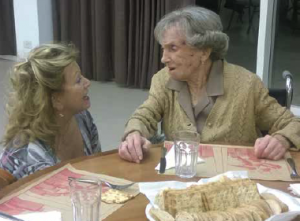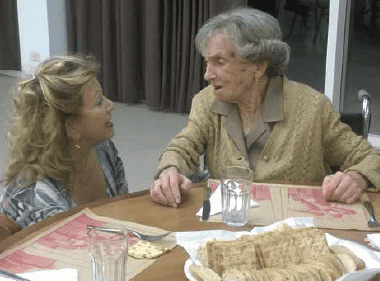
Mission Participant Honey Maizel chats with Marguerite during dinner. In her late-90’s Marguerite had been a young nurse in the early part of WWII. She came to Argentina after her native Belgium was liberated.
by Amy Zelenka
Sixteen members of the Tidewater Jewish community recently returned from a mission to the Jewish community of Buenos Aires, Argentina. Sponsored by the United Jewish Federation of Tidewater, the mission allowed local donors to “follow their campaign dollars” to one of the many overseas communities served by Tidewater’s Annual Campaign.
This is the third in a series of “Postcards” from the mission, highlighting some of the most impactful experiences.
It’s Friday evening and the mission participants arrive at the doors of their next visit. The LeDor VaDor Senior Home in Buenos Aires shines a spotlight on the work of the Federation’s overseas partner, the American Jewish Joint Distribution Committee (JDC).
Argentina is a unique chapter in JDC’s “book of stories.” It’s a chapter whose ending appears nearer and nearer. JDC’s presence on the ground in Argentina was built up during the economic collapse (1998–2002). During that crash, the upper and middle class segments of the Jewish community were hit disproportionately hard. Overnight, hundreds of families went from being donors and supporters of the community’s agencies to being recipients of their assistance. The depression was marked by a collapse of the Argentine economy (which shrank 28%), significant devaluation of the country’s currency, and staggering levels of unemployment. Hit especially hard were small businesses and small manufacturers, many of them Jewish-owned.
The Argentine Jewish community found itself in crisis, and the Federation system mobilized immediately, running emergency campaigns and working closely with JDC and World ORT (another overseas partner). JDC became the convener of dozens of Jewish communal agencies and programs in Argentina—spanning all streams of Judaism. Each was vetted, examined, and rated in terms of its health and long-term viability. To keep the Jewish community running (and with the knowledge that better days would eventually come), painful decisions were made.
Among those decisions were to close some of the community’s institutions, consolidate others, and restructure still more. Schools and synagogues were merged. Organizations were phased-out. A Jewish nursing home (located in an old, rundown building on the outskirts of town, away from the majority of the Jewish populations) was slated to be closed and its residents moved to a new building, closer to the center of town. Few were happy about the changes, but in the end, they agreed that the restructuring was needed—to be able to stretch the emergency funds— until those better days came.
Fast-forward to this past October. Better days did come to Argentina, and to the Jewish community there—now lean and efficient (thanks to the changes made during the crisis). And while the Argentine economy is by no means strong or steady (just ask the Argentineans who went to the ballot boxes as we flew back to the States!), the situation is far better than it was in those dark days of the late 1990’s and early 2000’s.
The mission participants entered a beautiful, state-of-the-art, Senior Home at LeDor VaDor. Bright open spaces, floor to ceiling glass windows, soaring ceilings, gleaming floors, sliding walls, every architectural element one could wish for (to make one happy) resided in the entrance to this building. And the aesthetics continued to please as the group made its way around the facility, looking in at resident rooms, common spaces, activity rooms, therapy spaces, dining halls, and a beautiful chapel.
Viviana Bendersky from the JDC spoke with the group and described the changes that had taken place in the building (which houses 350 residents, and was funded by the community with seed money from JDC) since LeDor VaDor opened its doors in 2007. She spoke of a variety of programs which had been housed in the building over time. One of them was JDC’s Baby Help Program—which had been established in 2003 to assist the poorest Jewish babies, toddlers, and pregnant women following Argentina’s economic collapse. Until recently, the Baby Help program had been housed at LeDor VaDor. It was a beautiful model, which facilitated intergenerational activities between Baby Help children and elderly residents of the home. Other programs rotate in and out of LeDor VaDor, allowing the community to mix and mingle with residents and keep the activities of the Home lively and intergenerational.
The group enjoyed a beautiful Kabalat Shabbat service with residents, which featured a local singer. The mission women had the honor of lighting the Shabbat candles and delivering the Motzi before moving into the chapel for Shabbat services, led by the Home’s director. Following services the group went into the dining hall for dinner and (English-speaking) discussions with the residents. Their stories were fascinating. Some talked of living through the Holocaust in Europe, only to come out on the other side with no surviving relatives and no home to which to return.
An irony of Argentina (one of many, as the group learned) is that not only did a large number of Holocaust survivors make their way to the country after liberation, but so too did a large number of Nazi criminals and murderers. This was a frequent topic of conversation throughout the mission.
The seniors charmed the group with engaging stories, but it was obvious that the population of the Home was quite frail and elderly. Only a dozen or so seniors joined the group for dinner. Most, it turned out, opted to eat nearer their rooms.
The visit to LeDor VaDor gave the mission participants an opportunity to engage with the community’s seniors and to learn from them the checkered and storied history (old and recent), which had brought them to that moment in time. Apropos of having visited earlier in the day with the young adults just back from Israel (at the AMIA building), the LeDor VaDor visit brought the day full-circle.

